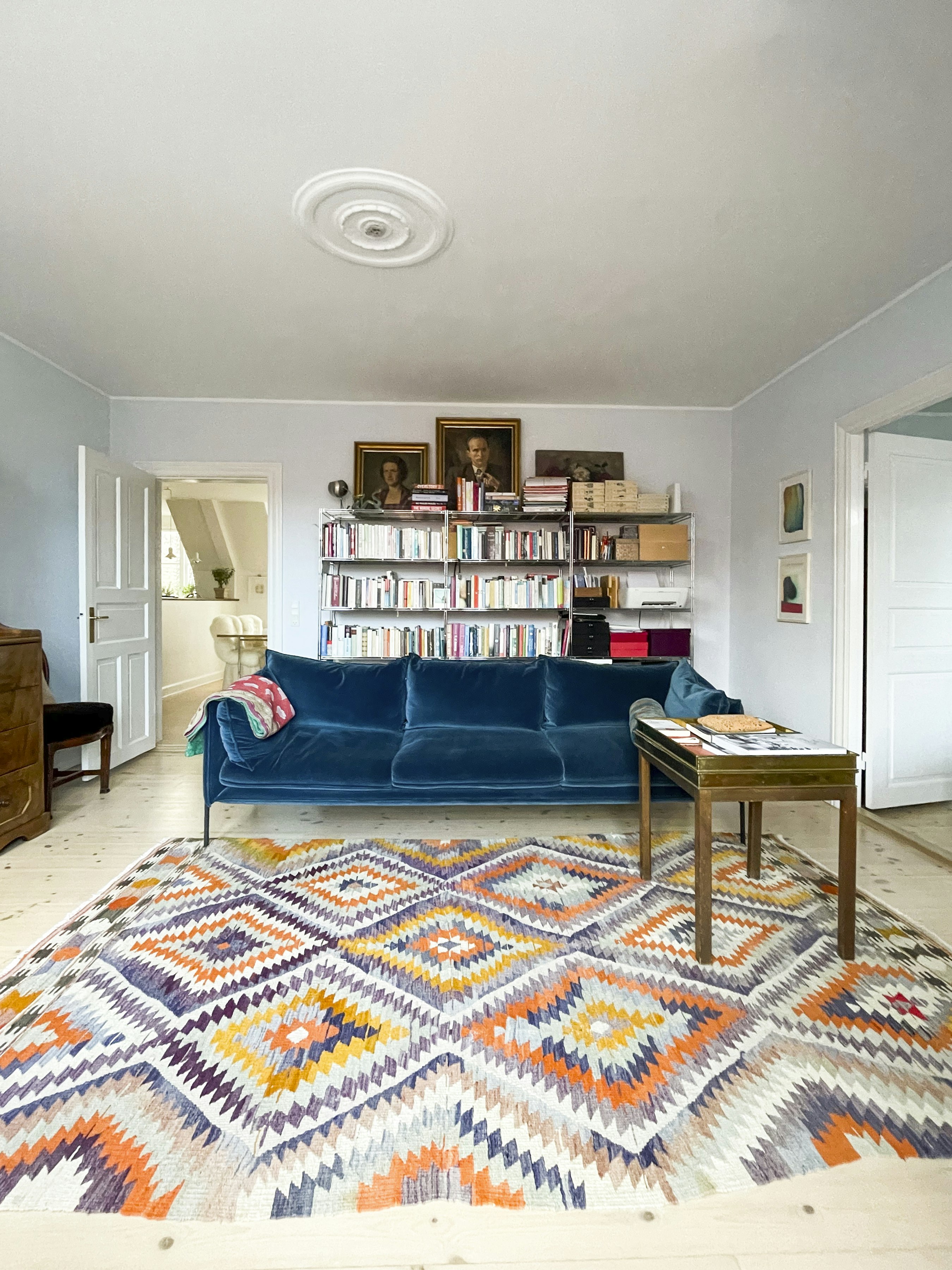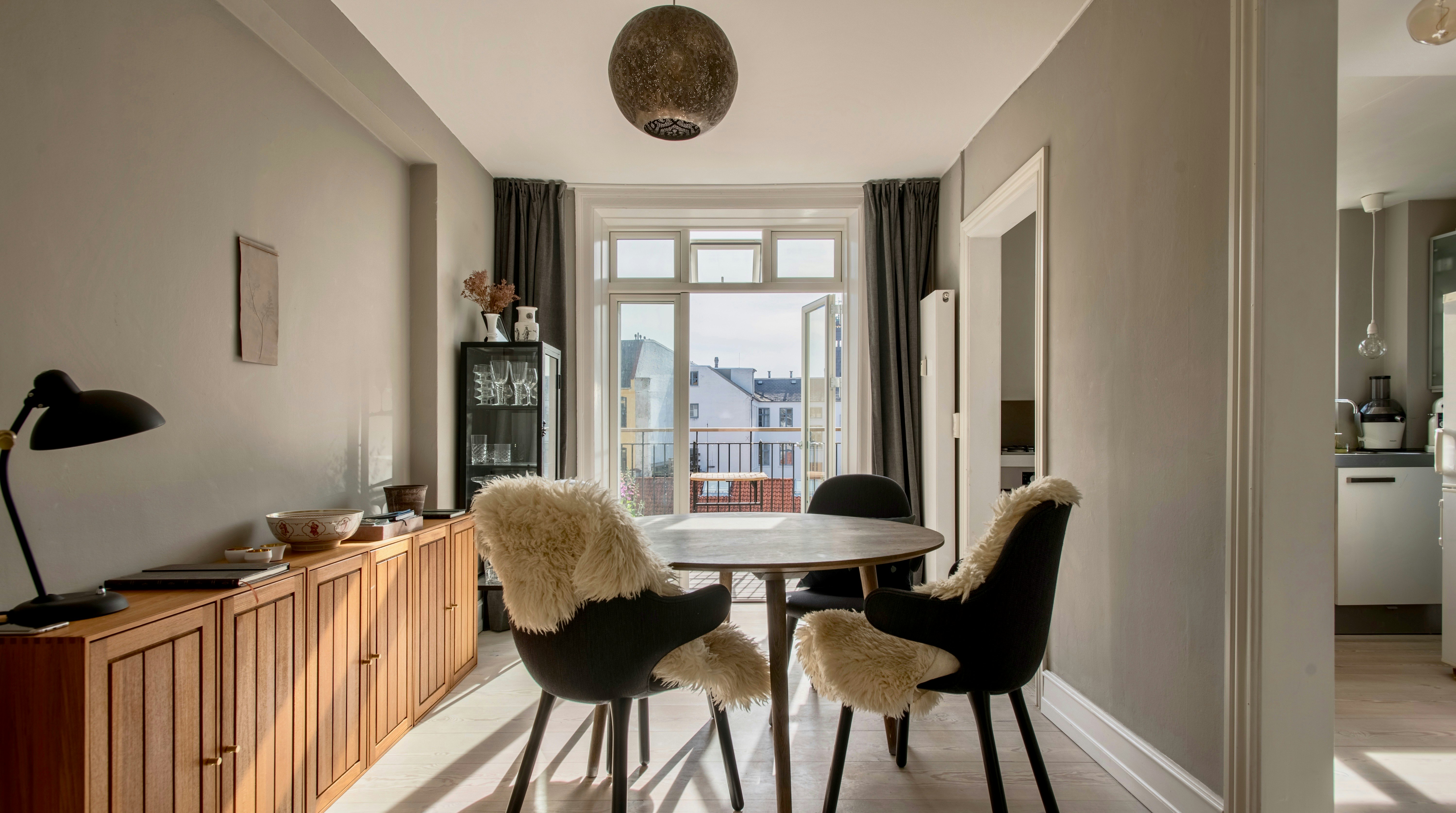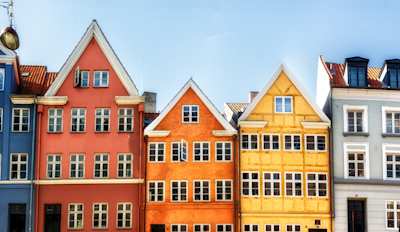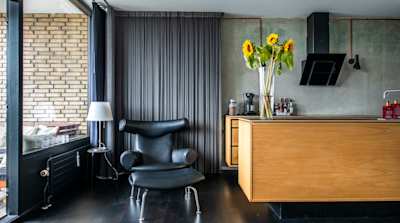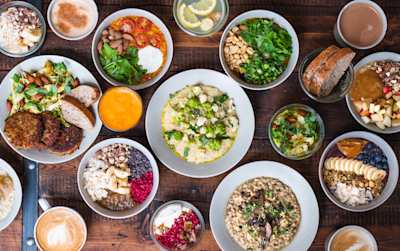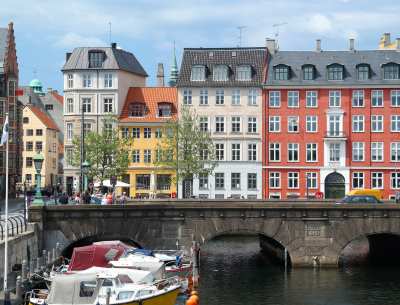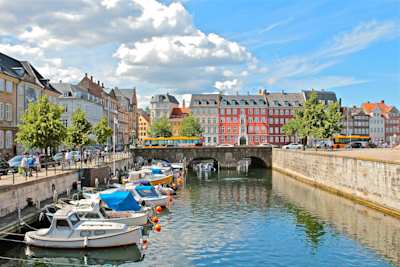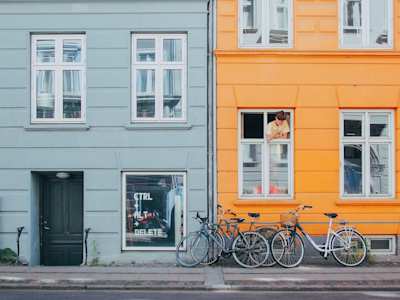Where To Stay in Copenhagen? We're Glad You Asked
Heading to the Danish capital and not sure which neighbourhood is right for you? Leave it with us to guide you to the perfect one. (We can guide you to the perfect Plum Guide home too.)
~
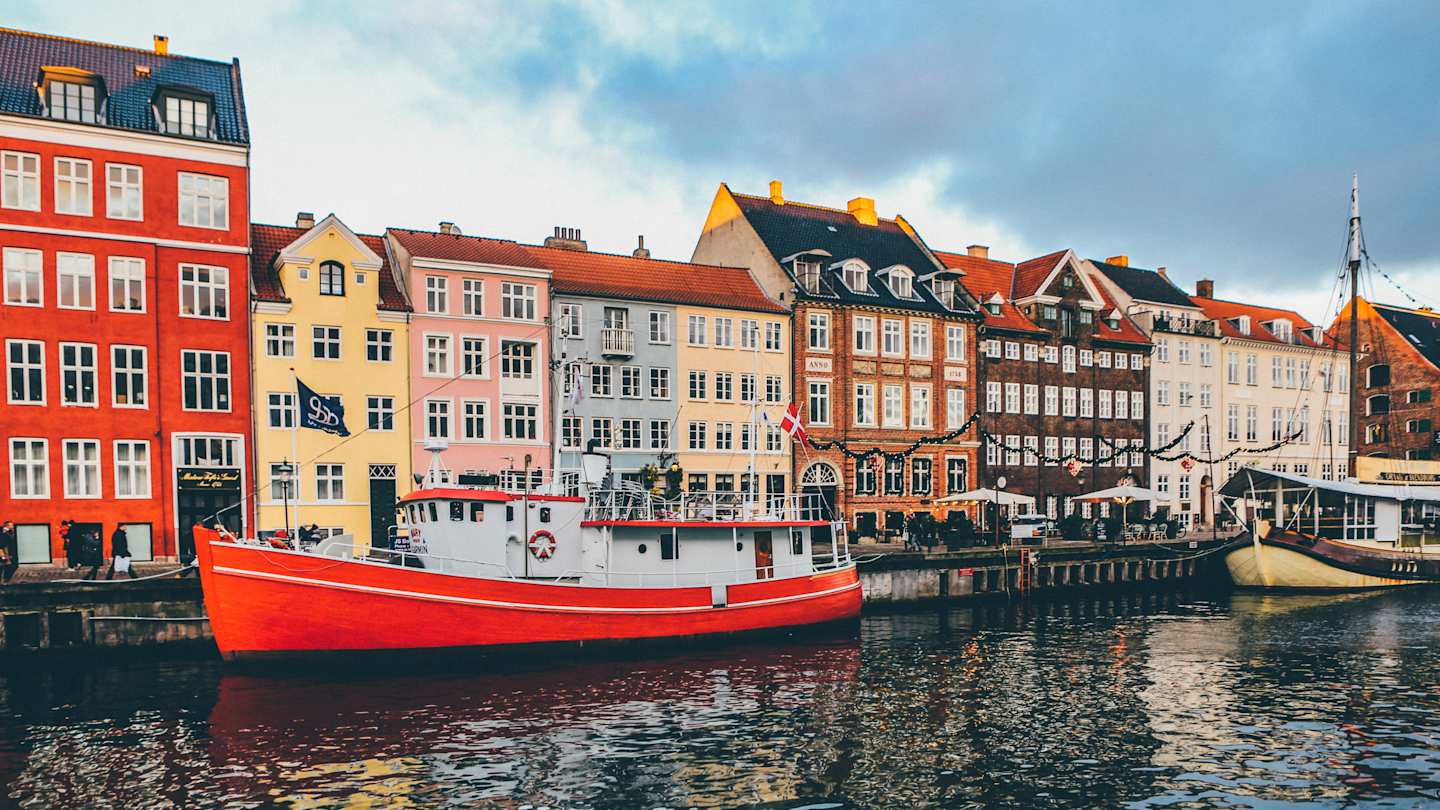
Ah Copenhagen, the city that gave us the prolific Scandi design trend, hygge, and a lot of impossibly good looking, tall, blonde people. Once an ill-fated port city that kept burning down in the 1700s, the Danish capital is now synonymous with effortless cool, a world-class dining scene (hello Noma), and incredibly high scores year after year on the World Happiness Index.
Despite the often blustery weather and a truly confusing infatuation with 7/11s, Copenhagen is one of those places you can’t help but fall in love with - the candy-hued houses lining the water, cosy cafés at every corner, and easily explorable by bike (fun fact: CPH is on its way to becoming the first completely carbon-neutral city by 2025). We here at Plum Guide were smitten at the first whiff of cinnamon buns which seems to permeate the air here.
In a city as characterful as this, uncovering the local charm is imperative - don’t even think about staying at a chain hotel or (gasp) getting coffee at Starbucks. Luckily, you have us to hold your hand and walk you through where to stay and what to do in Copenhagen.
Vesterbro
The city’s arguably coolest neighbourhood is also its red light district, though nowadays you’re more likely to find boutiques selling hand-made ceramics than anything untoward. There are still relics of Vesterbro’s sordid past though, giving this area a unique character to discover when choosing where to stay in Copenhagen.
A typical day in Vesterbro
Wander from the train station, with its lingering grit, down now-fashionable Istedgade, perusing independent shops, vintage boutiques and antique dealers. Keep on past creative startups and locals out having coffee until you find yourself in need of a pick-me-up of your own. Grab a latte and lunch, and enjoy a moment of hygge at Cafe Dyrehaven with its artsy crowd and repurposed vinyl booths. Mad & Kaffe is another great spot for smørrebrød and local brews of both coffee and beer. After lunch, stroll around family-friendly Skyebanehave park, bordered by a Neo-Gothic shooting range wall and mansion. Come dinnertime, there is no shortage of options on and around Vesterbrogade. The organic rotisserie chicken at Chicks by Chicks is the perfect antidote to a chilly day. For something a little more gourmet, try PONY. For post-dinner drinks, you can't miss the award-winning cocktailsat Curfew.
Meatpacking District aka Kødbyen
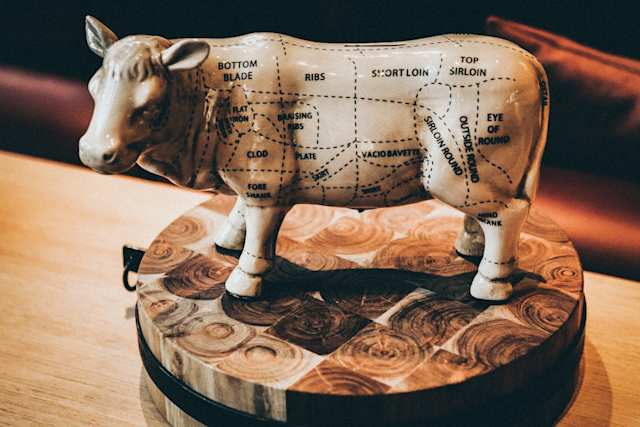
cow with text figurine
While technically part of Vesterbro, this hip enclave is deserving of its own spotlight. Quite literally the old slaughterhouse district, The Meatpacking District is now what its New York counterpart was in the late nineties. (For anybody who missed that episode of Sex and the City, firstly tut tut and secondly what we mean by that is that it’s on the up amongst the artsy, trendsetting set.) Admire the heritage protected architecture of the neighbourhood, with repurposed factory buildings characterised by their classic terracotta flooring and white-tiled walls.
A typical day in Meatpacking District
What you’ll really want to do here is eat and drink - but isn’t that the case everywhere you go? First though, you’ll have to work up an appetite. With that in mind, you’ll spend the afternoon ogling art at the many galleries dotted around Flæsketorvet square. Some of our favourites are the politically-inclined installations at V1 gallery, contemporary pieces by international artists at Galleri Bo Bjerggaard and the revolving photography exhibitions at Fotografisk Center.
Now that you’ve earned yourself some dinner, you’ll find yourself feeling spoilt for choice. You can't really go wrong in this neighbourhood, but if you’re after the best (and why wouldn't you be?) you’ll want to check out Fiskebaren, a sustainably-minded seafood joint which has earned itself a Michelin Bib Gourmand for its fresh catches, great natural wine selection and unfussy atmosphere. Not a seafood lover? Mother doles out wood-fired pizzas and boasts a lovely terrace for sunny days, or for authentic Mexican fare make a beeline for Hija de Sanchez, voted one of the best street food stalls in Europe and owned by a Noma alum. Later in the evening, check out what’s going on at Jolene, a no-frills, LGBT favourite hotspot where you can drink cheap beer and dance until the early hours.
Nørrebro
Nørrebro is Copenhagen’s biggest nod to refreshing multiculturalism. Here, you’ll find hipsters aplenty, and with them the requisite watering holes, independent shops and international food options. If you consider yourself to be in any way young and hip (or maybe just hip then), when asking 'Where to stay in Copenhagen?' this is your answer.
A typical day in Nørrebro
Starting your day at Grød is practically mandatory - this cosy breakfast nook puts your usual bowl of porridge to shame with its extensive list of toppings. Feeling thoroughly full and comforted, walk off your breakfast with a visit to Assistens Cemetery, the resting place of Hans Christian Andersen and Søren Kierkegaard amongst others. Whether or not morose Danish literature is your thing, the cemetery is a beautifully leafy spot for a stroll. For a mid-afternoon re-fuelling, head to Dépanneur, a Montreal-inspired cafe and convenience store where you can sip a glass of house-made Lambrusco, enjoy a cold brew and try organic snacks.
If you’re visiting between April and October, head to the long, narrow lane that houses Loppemarked flea market, where you’ll find a treasure trove of vintage furniture, jewellery, clothing, and bric-a-brac you definitely <s>don't</s> need. If you’re visiting outside flea market season, there are still plenty of shopping opportunities nearby. Meander down Ravnsborggade to score unique pieces of upcycled and antique furniture - there’s a seasonal flea market on this street too. On the neighbourhood’s main thoroughfare, Jægersborggade, stop in to Resecond to swap your old designer threads for something new (or new to you, rather - everything here is vintage), bring home some handmade wares from Vanishing Point and browse the many other beautifully-curated boutiques and vintage shops along the street.
Once you’ve given your purse a good workout and you feel pleasantly loaded down with shopping bags, you’ll need dinner. For seafood, local gem Oysters & Grill is amongst the best in the city, or try Kung Fu, a Japanese Izakaya and bar with trendy airs. Stomach sufficiently lined, you’ll be ready for a night at one of the many bars lining Blågårdsgade street.
Osterbro
While mainly an upmarket residential neighbourhood populated by young families, Osterbro can claim more than a few notable points of interest to its name. Tourists flock here en masse to check out the Little Mermaid statue, a homage to Hans Christian Anderssen’s beloved fairytale.
A typical day in Osterbro
While you could start with the Little Mermaid and get that checked off the bucket list, we think it’s an especially pretty view around sunset, so save that for later. For now, you have parks to explore and museums to visit. Have a wander through Copenhagen’s largest park, Fælledparken, where you can join young families and some good puppies out for a walk. Telia Parken, at the end of the park, is Denmark’s National Stadium, and home to the city’s football team. Unless you’re here to catch a game, you’ll want to walk in the other direction, towards the lakes. En route, detour via Osterbrogade to shop for designer homewares at Rambow, before stopping by I Blame Lulu, an expertly curated consignment shop on Rosenvængets.
If you’re too hungry or the weather is too cold to entertain the idea of walking to the lakes for a picnic, take refuge at Cock and Cows next door for the best burgers in the city (also takeaway-able), or Dag H for expert-approved coffee and serious brunches. Continue on to the lakeshore - whether you’re picnicking and setting up shop here for the afternoon, or just passing through, it’s well worth a pit stop. If you haven’t been seduced by a lazy afternoon by the water, keep walking until you reach Østre Anlæg park. Amongst the beautifully manicured gardens here, you’ll find seven museums to explore: SMK National Gallery of Denmark; Rosenborg Castle with its 400 years of royal history; the Natural History and Geological Museums; the Hirschsprung Collection, featuring 19th and 20th century Danish art; the Workers’ Museum, dedicated to the city’s working class and industrial history; The Palm House and Botanical Gardens; and The David Collection, which houses an impressive private art collection. See them all with one ticket, or pick and mix as you see fit. If you want to do them all, be warned (or warn whoever you're with) that it’ll take all day.
Congratulations - you’ve now earned your Instagram-op with the Little Mermaid. You’ll find her waiting at the end of Langelinie pier, beckoning in all the cruise ships that come to port here. For dinner, vegetarians and omnivores alike will revel in the veg-focussed, organic fare at VeVe. For more serious herbivores, Souls offers up plentiful vegan and gluten-free options. Otherwise, go upscale at Geranium, holder of three stars in the 2019 Michelin Nordic Cities Guide.
Christianshavn
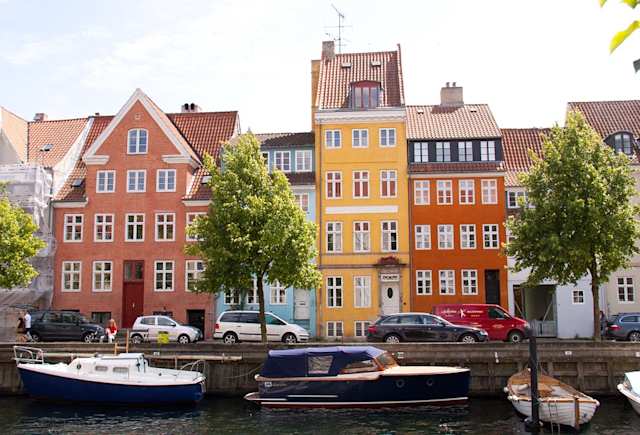
Canal, Copenhagen, Christianshavn, Harbour, Capital
Often compared to Amsterdam for its fairytale architecture, quaint cafes, and bridges crossing the canal, Christianshavn was originally founded as an independent merchant’s town within greater Copenhagen. Today, this residential neighbourhood retains its nautical character and is home to one of the city’s most iconic sights: the copper spire of the Church of Our Saviour.
A typical day in Christianshavn
Get up early and join the locals for breakfast at Parterre, a basement cafe with exceptionally good lighting. After breakfast, it’s time for a little hike (aka walking up some stairs) to the helix of the beautiful Baroque church mentioned above. Cardio workout done for the day, you may be red faced and sputtering when you reach the top (just us?) but you’ll be rewarded with picturesque views of Copenhagen’s terracotta rooftops and the sparkling water beyond. Hunker back down again and hit the streets, because there’s a lot of ground to cover if you want to make your 8.30 pm reservation.
Back on sturdy ground, your first stop is Overgaden, a not-for-profit contemporary art space with a revolving roster of exhibitions by up-and-coming artists. From there, you’ll take in your second church of the day. Christian’s Church is a Rococo-style beauty with three stories of galleries from which to ogle the gleaming interiors. Feeling definitively more holy than you did when you woke up this morning in your Plum Guide home, your next bit of impressive architecture comes to you by way of the Opera house. The building, all neo-futuristic lines and stark edges, is amongst the most modern opera houses in the world - design buffs would surely salivate at the idea of a guided tour.
If that resonates with you, you may also be interested in having a little sniff around the nearby KADK library for architecture and design. After that, you might be ready for a little break - weave through the canal bridges before finding a spot at UNDICI, offering pretty views over the water and a great Italian-style aperitivo. Now is your moment of truth: if you’re a die-hard gourmand with money to burn and the foresight to book a season in advance, then you’ve had your Noma reservations sorted for months now. On the more cheap-and-cheerful side of things, opt for street food at Bridge Street Kitchen, where some of the city’s best eateries have outposts under one market hall roof.
The Freetown Christiania
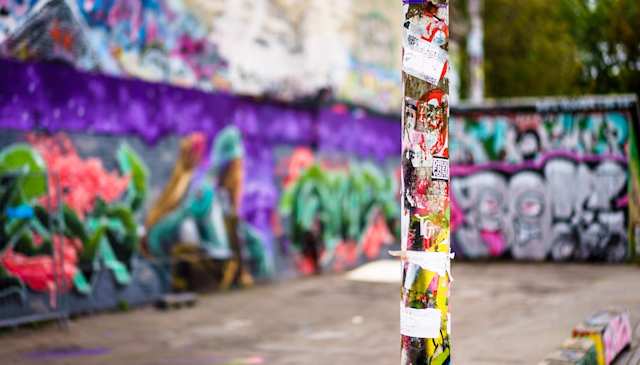
selective focus photography of rod with graffiti
Technically within the Christianshavn confines, Freetown Christiania is a self-governing enclave where the aroma of cannabis fills the air, yogis fill the park and peaceful anarchy is the law of the land. The now touristy hub was originally a military barracks, claimed as squats by a bunch of hippies and homeless people in 1971. Since then, Christiania has been all about communal living, self-sustainability and... Allowed to act as an independent city-state until 2004, cannabis used to be legal only in this neighbourhood - today, you can still find it rampant on Pusher Street, but many residents of Christiania say you shouldn’t buy here because of clashes the now-illegal trade has caused with police. Still, Freetown Christiania is a unique example of peaceful commune life within a city that you won’t really find anywhere else - we dare to even think what would happen if residents of London, New York, or any other big capital city were allowed to exist in an essentially lawless state within the metropolitan area.
A typical day in Freetown Christiania
All you really need to do here is walk around and you’ll organically happen upon local art galleries, shops and craftspeople’s workshops, all tucked behind ramshackle housing splashed with bright, trippy paint jobs. If you’re after cheap flea market-esque souvenirs or unpretentious local art, this is your place to shop for it - the aesthetic is emphatically uncurated and unpolished. Here, the pace is slow, the people friendly and the prices affordable - despite being a well-trodden tourist circuit these days, there’s still something holistic feeling in the air.
Stop for lunch at Morgenstedet, a vegetarian self-serve co-op eatery located in a quaint white-washed cottage. Cross the bridge for a different kind of greenery (the nature kind) and pretty views. In summer months, don’t miss the free concerts every Sunday evening at Café Nemoland, where you can sit outside with a beer and a burger and listen to Danish musicians. It’s well worth staying in this part of town after dark for its alternative nightlife and live music, the best of which can be found at Loppen.
Frederiksberg
Frederiksberg is the upmarket bit of Copenhagen (though, most of Copenhagen is arguably pretty upmarket - must be something to do with that high standard of living we mentioned earlier). As you meander about, take in the gleaming facades of Frederiksberg’s buildings - the borough has a city by-law written in, protecting the stylistic and architectural integrity of its classicist homes.
A typical day in Frederiksberg
You could easily spend the day here visiting the area’s touristy sights - start at the Copenhagen Zoo before heading on to Frederiksberg Palace and Gardens, a 17th Century Italian-style former royal residence which sits on a hill, surrounded by landscaped gardens. Skip the guided tour and instead spend the morning exploring The Cisterns, catacombe-esque maze of tunnels that used to be the city’s water reservoir but now houses contemporary art exhibits and events. Our favourite part of Frederiksberg though, is Værnedamsvej, a boutique- and cafe-lined street towards the Vesterbro end of things that’s reminiscent of Paris’ Saint-Germain-des-Pres. Start with lunch amongst retro bric-a-brac furniture at neighbourhood institution Granola, shop for French delicacies at the aptly-named Le Gourmand and pop in and out of cheesemongers, speciality wine shops, and butchers’, tasting as you go - now’s the time to sample some of that famous Danish blue cheese.
Of course, the Paris comparison couldn’t be complete without high-end shopping: explore beyond the gourmet mecca of Værnedamsvej to discover gems like Studio Rov, a Scandi design-lovers dream with ceramics from local makers and a crisp aesthetic; bespoke shopping experiences at nué; and Danish designer Sophie Schnoor’s flagship store. However, if window shopping for nice things you can’t have isn’t your bag, we recommend redirecting your attention to the much more accessible retailers in Vesterbro and Norrebro (see above). In the evening Frederiksberg is all about refined but laidback dining, and you’ll find many a bistro to park yourself in for a leisurely meal. Les Trois Cochons leans towards classic bistronomy in both food and decor, with black-and-white tiled floors and banquette seating. Restaurant Melée is another great option for rustic, soul-soothing, French fare in a warm setting.
Nyhavn
When you close your eyes and think of Copenhagen, this is probably what you’re picturing: colourful, 18th century homes sitting pretty by the waterfront, reflecting onto the water, maybe a sailboat casually bobs by… it’s an idyllic picture, and you’ll find it here. While those houses you’re familiar with from friends’ travel photos were once homes to the likes of Hans Christian Anderssen and many a lady of the night (respectively, we assume) they are now bustling bars and restaurants full of throngs of tourists year-round.
A typical day in Nyhavn
During the Christmas season, the harbourfront turns into a veritable winter wonderland with the Nyhavn Christmas Market, with stalls selling gluhwein (that’s mulled wine, to you), Danish handicrafts, seasonal snacks, piping hot pretzels and pastries and many a trinket to bring back as gifts. Jaunty live music plays and you’ll likely spend a lot of time elbowing your way through the crowd of fellow market-goers, but the magic of Christmas somehow renders that a less irritating experience than it would be anywhere else. In the summer, the same strip is the most scenic spot to sip a pint or two to the backdrop of buskers playing jazzy tunes.
But Nyhavn is more than just its port. Looped in with the Royal Quarter to form one large neighbourhood, it’s here that you can scope out the Queen’s Palace and its three adjoining royal residences at Amalienborg Slot square. Continue on to Frederik's Church, an imposing marble affair inspired by St Peter’s Basilica, and Det Kongelige Theatre, home of the Royal Danish Ballet and a lot of pomp and circumstance. Once you’re full up on historical sights, load up on lunch at local institution Ida Davidson, whose family has been in the smorrebrod business since 1888. Afterwards, stop by Meyers Bageri for a truly life-changing kanelsnægel - aka a cinnamon roll laced with sugar and creamed butter.
At this point, you have a choice to make. You can lean in to the tourist thing and take a guided tour of the canals before hopping off at the harbourfront and settling into one of those aforementioned restaurant terraces. Locals and tourists alike flock to Michelin-recommended Hummer to splash out on fresh seafood or head to Gorm’s for wood-fired pizza like they do it in Italia. Spend the evening people-watching and revelling in the postcard-perfect views. Otherwise, veer away from the water and head to Rebel, a laid-back spot serving modern Danish sharing plates, before swilling down a few glasses of biodynamic wine at Den Vandrette (you could happily eat here too - the menu changes daily and focuses on organic produce).
Indre By
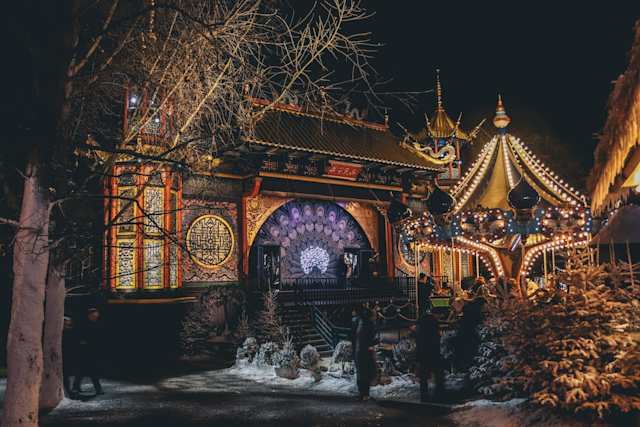
photo of people standing near carousel
Indre By is the city-centre - buzzing with restaurants, bars, international retailers, and souvenir shops a-go-go lining Stroget, its main street. It’s also home to some of the most iconic Copenhagen must-dos: Rundetaarn observatory and Tivoli Gardens. If you stay in Times Square when you go to New York or Covent Garden when in London, Indre By is where you’ll want to be. Locals may turn up their noses, but for optimal sightseeing, easy access to just about everything and beautifully historic buildings lining your way, you’ll be the one having the last laugh. Once you’re done with the neighbourhood sights, you can easily explore all of Copenhagen by foot, bike, or metro.
A typical day in Indre By
There is only one way to fuel yourself up for a busy day of sightseeing, and that’s with coffee at Coffee Collective. These guys have outposts around the city, and are largely regarded as the best in the business. Now, walk over to Rundtaarn, a 17th Century former astronomer’s observatory, where you can climb the spiral tower for panoramic views over the city. Photos sufficiently captured, get yourself back down to street level and stroll over to Torvehallerne, the city’s iconic indoor market where you’ll find locals shopping for the freshest produce, finest charcuteries and fish, and artisanal products galore. Sidle up to one of the food counters for a snack or shop around and assemble your own picnic lunch to eat near the water. If you’re like us, you could easily lose a few hours here, but we implore you to keep on going because there’s still lots to see.
Next stop: Tivoli Gardens. If you’re visiting Copenhagen with kids, this is probably where you’ll spend a good chunk of the day. The whimsical amusement park and gardens were opened in 1843, making it the second-oldest amusement park in the world - no big deal. Whether you’re wanting to ride the vintage rollercoaster, go up the ferris wheel, or just stroll around the gardens with a snack (there’s a note-worthy food hall here too), Tivoli is a can’t-miss experience. During Christmas, they also host what is arguably the most magical market in the city (which is a tall order, because they’re all pretty great).
From there, you can either do the culture-vulture thing and visit the National Museum of Denmark, Copenhagen Museum and the Ny Carlsberg Glyptotek, all congregated just next to Tivoli, or you could redirect your attention to Stroget street for an afternoon of shopping. Either way, pass by City Hall Square. If you’re heading the Stroget way, the impressive Magasin du Nord sits at the mouth of the street, and aside from being architecturally beautiful, is also the home of designer brands for men, women, and children, homewares by Danish designers (Royal Copenhagen, Gerog Jensen, etc) and of course, a food hall where you can stock up on treats to bring back home (or just walk around eating free samples like we do).
As with everywhere in this gastronomic utopia of a city, there is no shortage of dining options around. Go high at Pluto for Bib Gourmand-awarded family-style plates, sustainable Nordic fare at Marv & Ben, or Krog’s, a white table-cloth institution that’s been around since 1910 and serves excellent fish and seafood. Or, opt to not bankrupt yourself and tuck in to trendy Nordic grub at Höst or big bowls of ramen at Slurp. After dinner, have a beautifully-crafted seasonal cocktail at Ruby before joining the masses at one of the clubs in the area. Nightlife around here is exactly what you’d expect from a busy, often-touristy city centre - Chateau Motel and Culture Box are well-trodden spots, but if you’re after something a little cooler and more alternative, redirect yourself to the Meatpacking District, Vesterbro, or Norrebro. If you’re looking for a more chilled evening in the city centre, Jazzhus Montmartre is a legend that’s been around since the ‘50s.
So there we have it, our very detailed guide on where to stay in Copenhagen. With so many great options to choose from, no doubt you're debating which neighbourhood is the perfect one for you. Once you've made up your mind, next up is to decide on your luxury Plum Guide home in the city. Our home critics have tested every one of them to ensure only the highest of standards for you...because, well, you deserve it.
